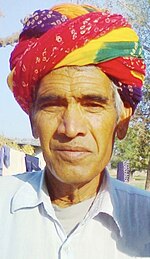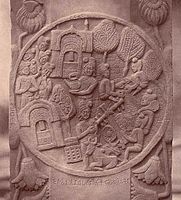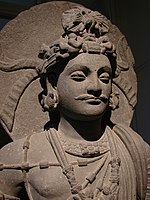Specific styles

khirki-dār-pagari
Methods of binding the pagri are innumerable, and khirki-dar-pagri is one particular style of dressing the turban. Khirki-dar-pagri means the turban with a window. Brocade piece may decorate the turban.[3]
Paag
|
Main article: Paag |
The paag is a headdress in the Mithila region of Bihar and in Mithila, Nepal.
Pheta
|
Main article: Pheta |
Pheta is the Marathi name for the traditional turban worn in Maharashtra, India. In ceremonies such as weddings, festive and cultural and religious celebrations as well it is common to wear Pheta. In many parts it is customary to offer male dignitaries a traditional welcome by offering a Pheta to wear. A traditional Pheta is usually long cloth typically 3.5 to 6 metres long and 1 metre wide. The choice of colour may indicate the occasion for which it is being worn and also may be typical to the place it is being worn in. Typical colours include Saffron (to indicate valour) and White (to indicate peace). In the past, wearing a Pheta was considered a mandatory part of clothing.[4]
There are several styles of Pheta which are specific to regions, for example
- Kolhapuri and Puneri pheta
- Mawali pagadi (traditionally worn by Maratha warriors from the Mawal region of Maharashtra)
- Mahatma Phule pagadi famously worn by the Maharashtrian reformer, the activist from whom it gets the name.[5]

Peta
|
Main article: Mysore peta |
The peta is a turban worn in Mysore and Kodagu, it is the traditional indigenous attire worn by the erstwhile Kings of Mysore, called the Wodeyars (1399 to 1947), of the Kingdom of Mysore. Wodeyars wore a richly bejeweled turban made of silk and jari (gold threaded lace) to match with colourful dresses as part of the royal dress.
Administrators under the King, such as the Dewans' (Prime Minister appointed by the King) and other senior officials who swayed considerable power in matters of state administration also donned the Mysore peta.
After India became independent in 1947 and the princely state merged with the Indian union, the traditional Mysore peta has been retained as a symbol of heritage and cultural antecedents and distinguished people are honoured by the award of a Mysore peta with a shawl in formal functions.
Rajasthani pagari


Turbans worn in Rajasthan are referred to as the pagari and is also pronounced pagri. They vary in style, colour and size. They also indicate a wearer's social class, caste, region and the occasion it being worn for. Its shape and size may also vary with the climatic conditions of the different regions. Turbans in the hot desert areas are large and loose. Farmers and shepherds, who need constant protection from the elements of nature, wear some of the biggest turbans. The Rajasthani turban also has many practical functions. Exhausted travellers use it as a pillow, a blanket or a towel. It can be used to strain muddy water. An unravelled turban can also be used as a rope to draw water from a well with a bucket.[6]
Prominent styles are pencha, sela and safa, although several local variants exist. A conventional pagari is usually 82 inches long and 8 inches wide. A Safa is shorter and broader. Ordinarily a turban of a single colour is worn. However, turbans of one of more colours may be worn by the elite or during special occasions such as festivals or weddings, etc.[7] Rajasthani turbans are a prominent tourist attraction. Tourists are often encouraged to participate in turban-tying competitions.[6]
Peshawari pagri
|
Main article: Peshawari turban |
Peshawari pagri has been traditionally worn in Peshawar. It includes a cap called kulla and the cloth wrapped around it called lungi.[8]









